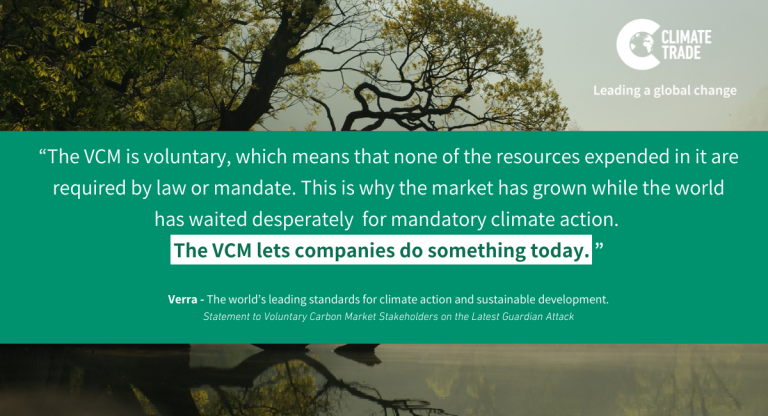The voluntary carbon market could be one of the most critical tools in the fight against climate change. However, it has faced several challenges and a lack of trust in recent years.
The voluntary carbon market helps to direct finance to emissions reduction and removal projects that otherwise would not receive financial support. While supporting global environmental projects should be considered a positive move, the industry has faced widespread criticism and public scrutiny. It is true that there have been cases of low quality carbon credits or companies greenwashing by emitting high volumes of emissions, these scenarios are few and far between. Most companies purchase carbon credits as a way to make a positive impact on the planet, in addition to their overall sustainability objectives.
A recent statement by Verra, a nonprofit organization operating within the VCM, pointed out that it is a voluntary market, so those companies and individuals purchasing credits are doing so not because they have to by law, but because they want to support climate efforts. They said: “the VCM is voluntary, which means that none of the resources expended in it are required by law or mandate. This is why the market has grown while the world has waited desperately for mandatory climate action: because it lets companies do something today.”
It is clear that we must urgently restore trust in the market, ensuring that carbon credits are delivering high-quality emissions reductions and removals.

Verra, a nonprofit organization, plays a crucial role in ensuring the trustworthiness of carbon credits. They do not sell credits or engage in market transactions but focus on overseeing the adherence of projects to program rules and standards. Projects registered under Verra can then hold, sell, or retire credits at their discretion.
What do people believe are the biggest risks in investing in the Voluntary Carbon Market?
Investing in Carbon Credits and participating in the voluntary carbon market present promising opportunities for environmental impact and sustainability efforts. A recent report by Sylvera, shared some of the top reasons why people may be hesitant to invest in the market.
Transparency – One significant concern, identified by 50.2% of stakeholders, is the lack of transparency regarding project quality and performance within the market. This opacity raises questions about the effectiveness of carbon credit investments.
Pricing – 36.0% of participants express apprehension about overpaying for carbon credits, highlighting the need for fair pricing mechanisms.
Limited expertise – 28.6% of those involved in carbon credit investments cite their limited resources and expertise as an obstacle to conducting thorough due diligence before making a purchase.
Carbon credit knowledge – 26.6% of individuals lacked clarity on when and how to buy or retire credits effectively
Negative Press – Concerns about public perception and negative press coverage also loom large, with 26.0% fearing in poorly rated or low-quality carbon projects.
Environmental Impact – 16.0%, pertains to the potential discrepancy between the claimed and actual environmental impact of carbon credits.
Greenwashing – 14.4% of stakeholders express concerns about the negative publicity surrounding greenwashing, emphasizing the need for rigorous certification and verification processes to combat misleading claims in the market.

The Life of a Carbon Credit
It is important to understand the complex journey of a carbon credit and identify key areas for improvement to build trust within the market. Carbon credits are not created overnight; they go through a meticulous process to ensure they are real, additional, verifiable, permanent, and unique. Here is a step-by-step overview of the typical life of a carbon credit as outlined by the RMI.
Project Design: It all begins with project developers who conduct feasibility studies and select methodologies for quantifying emissions reductions or removals. These methodologies can be pre-approved or proposed, but they must adhere to strict standards.
Registration: Once the project is designed, it must be registered under an accredited standard. Four major carbon standards, including Verra, Gold Standard, Climate Action Reserve, and American Carbon Registry, certify credits in the voluntary carbon market.
Monitoring, Reporting, and Verification (MRV): Registered projects undergo rigorous MRV processes to ensure they genuinely reduce or remove carbon emissions. Third-party verifiers are contracted to validate the accuracy of these claims.
Issuance: After successful verification, the project begins to issue carbon credits, with each credit representing one ton of carbon dioxide equivalent (tCO2e).
Transaction: Carbon credits reach buyers through various channels including our very own ClimateTrade marketplace, These transactions need to be transparent and trustworthy.
Retirement: The final buyer of the carbon credit “retires” it, signaling that they have claimed the environmental benefit. Once retired, the credit is permanently removed from the market. Our blockchain technology helps to reassure buyers as blockchain ledgers cannot be duplicated or altered.
Despite this meticulous process, the voluntary carbon market has been plagued by a lack of trust due to concerns about the credibility and transparency of these credits.

Photo from ClimateTrade project 528: Voluntary Biodiversity Credits by Terrasos
Banco de Hábitat, Bosque de Niebla – El Globo
Enhancing Transparency: The Role of Blockchain-Based Carbon Credits
Our innovative solution to address these challenges and build trust in the voluntary carbon market is our blockchain-based climate action platform. We aim to enhance transparency and trust by providing a secure and immutable ledger of carbon credit transactions.
Working alongside organizations like Verra and IETA (International Emissions Trading Association), we can offer real-time tracking of carbon credits, ensuring that credits are legitimate, additional, and transparent. This approach addresses some of the key concerns in the market and can contribute to restoring trust in carbon markets.
In 2021, the voluntary carbon market experienced an unprecedented surge, soaring to a value of $2 billion, which was four times its 2020 worth. Furthermore, the momentum in purchasing has continued to gather pace throughout 2022. Projections indicate that by 2030, the market is poised to expand to a range between $10 billion and $40 billion.
With this in mind, it has never been more important for VCM stakeholder to commit to building trust in the voluntary carbon market. It is an essential factor for its continued growth and effectiveness in addressing climate change. Trust can be achieved through enhanced transparency, the improvement of existing standards, and the adoption of innovative technologies like blockchain to provide real-time tracking of carbon credits. At ClimateTrade we believe with the collective efforts of organizations, governments, and investors, the voluntary carbon market can play a key role in mitigating climate change and protecting our planet. Ready to learn more? Start here to learn more about our climate technology solutions, or click the banner below to explore our Marketplace.








